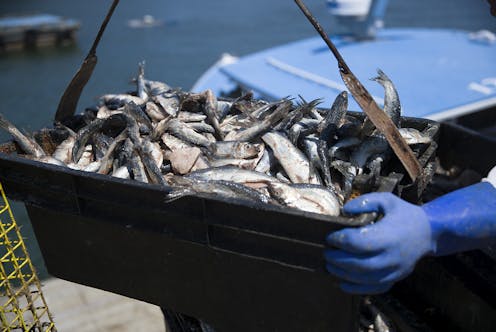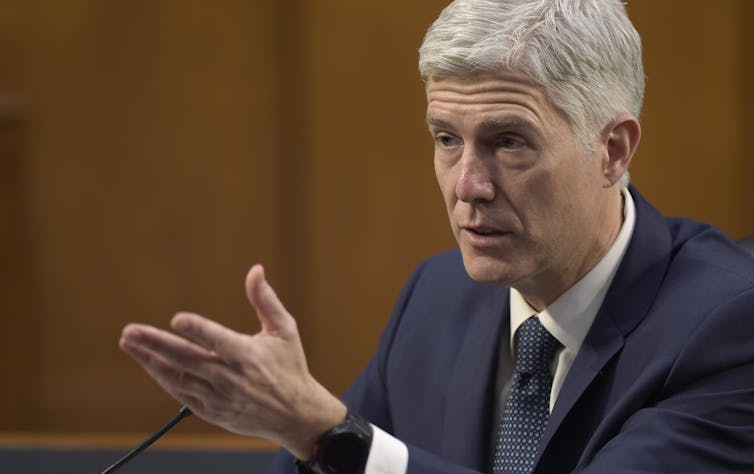
Fisheries regulation might seem to be unusual grounds for the U.S. Supreme Court to shift power away from federal agencies. But that is what the court seems poised to do in the combined cases of Loper Bright Enterprises vs. Raimondo and Relentless Inc. vs. Department of Commerce. The cases are scheduled for oral argument in tandem on Jan. 17, 2024.
The question at the core of both cases is whether the secretary of commerce, acting through the National Marine Fisheries Service and following the Magnuson-Stevens Fishery Conservation and Management Act, can require commercial fishers to pay for onboard observers whom they are required to take on some fishing voyages. In both cases, the plaintiffs assert that the Commerce Department has exceeded its legal authority. That claim turns on how much deference the court should give the agency’s interpretation of the Magnuson-Stevens Act.
Specifically, plaintiffs are challenging a nearly 40-year-old doctrine of federal administrative law, known as Chevron deference for the 1984 case in which it was set forth. This tenet provides that when a federal statute is silent or ambiguous about a particular regulatory issue, courts defer to the implementing agency’s reasonable interpretation of the law.
In other words, if the agency and federal courts disagree about the “best” interpretation of a federal law, the courts cannot force the agency to accept their version of what the statute means or allows, so long as the agency’s own interpretation is reasonable.
Who pays for fishing monitors?
Under the Magnuson-Stevens Act, eight regional Fishery Management Councils regulate fisheries in federal waters that lie more than 3 nautical miles from shore. When these fisheries are overharvested or in danger of becoming so, these councils create management plans that are designed to end overfishing and bring the stock back to health. The National Marine Fisheries Service reviews the plans and publishes regulations to carry out those that it approves.
The law makes clear that these plans can require fishing boats to carry observers who monitor their catch. These trained biological technicians collect data on what the vessel catches, what it throws back and how its fishing affects protected species such as marine mammals and sea turtles.
However, the law does not state whether federal regulators can require the fishing industry to pay for these observers. The general background presumption in federal regulatory law is that regulated entities pay their own compliance costs. As an example, since 1990 the North Pacific Fishery Management Council has required the industry to partially fund its fishery observer program for groundfish and halibut through fees.
Targeting Chevron deference
Loper Bright and Relentless Inc. are fishing boat owners who are challenging 2020 regulations that require Atlantic herring fishers to pay some costs for observers on their boats. The Atlantic herring monitoring program seeks to put observers on 50% of fishing trips, with the National Marine Fisheries Service paying part of the cost and fishers paying the rest.
The companies complain that observers can cost up to $710 per day and reduce owners’ profits by up to 20%. The challengers in the Relentless Inc. case have fish-freezing equipment onboard their boats that enables them to stay longer at sea. Longer voyages mean they must pay more for the required herring monitors, even though on many days they will not be fishing for herring. Federal courts of appeals ruled in favor of the National Marine Fisheries Service in both cases.
The companies originally challenged multiple aspects of the 2020 regulations. However, the Supreme Court agreed to address only one question that each petition raised: whether the court should overrule the Chevron decision, or at least clarify that when a law is silent about an agency’s powers, federal agencies receive no deference from the courts when they interpret the scope of their own regulatory authority.

Who decides what the law means?
The Supreme Court created Chevron deference in a 1984 air pollution case, Chevron USA Inc. vs. Natural Resources Defense Council Inc. The case centered on the U.S. Environmental Protection Agency’s interpretation of the term “stationary source” in the Clean Air Act.
The EPA had decided that a “source” could be a facility that contained many individual sources of air pollutant emissions. This meant, for example, that a factory with several smokestacks could be treated as a single source for regulatory purposes, as if it were enclosed in an imaginary bubble.
This approach benefited industry: A facility could reduce emissions from the sources that were cheapest to upgrade and let its expensive-to-fix sources keep polluting, so long as its overall emissions under the “bubble” met the Clean Air Act’s requirements. Environmentalists sued, arguing that every individual smokestack or pollution source needed to be regulated.
In upholding the EPA’s decision, the court created a two-step test for deciding whether to defer to a federal agency’s interpretation of a statute that it administers. In Step 1, the court asks whether Congress directly addressed the issue in the statute. If so, then both the court and the agency have to do what Congress directs.
In Step 2, however, if Congress is silent or unclear, then the court should defer to the agency’s interpretation if it is reasonable, because agency staff are presumed to be experts on the issue. Justice John Paul Stevens reportedly told his colleagues, “When I am so confused, I go with the agency.”
Curbing the administrative state
Chevron deference has given federal agencies considerable flexibility to use statutes to address new and emerging problems that Congress did not anticipate.
For example, the U.S. Fish and Wildlife Service now lists species for protection under the federal Endangered Species Act based on “foreseeable” risks to the species from climate change, even if most actual impacts are decades or even a century away. Similarly, courts deferred to the Department of Labor during the COVID-19 pandemic when it protected workers from mass layoffs without warning.
However, some members of the current Supreme Court – as well as some federal appellate judges – have criticized Chevron deference for two key reasons.
First, the doctrine gives executive branch agencies authority to interpret federal law. However, since the Supreme Court’s 1803 decision in Marbury vs. Madison, it has been the duty of courts – not federal agencies – to say what the law is. Justices Neil Gorsuch, Clarence Thomas, Samuel Alito and Brett Kavanaugh have all indicated that they think Chevron deference allows federal agencies to usurp this core judiciary function.
Second, Chevron deference also arguably allows federal agencies to grab more regulatory authority than Congress intended them to have, usurping the legislative branch’s responsibility to make law and delegate authority. The current Supreme Court is particularly interested in policing these alleged power grabs.
Justices have stated this concern most obviously in the recently articulated “major questions doctrine,” which holds that agencies may not regulate on questions of “vast economic or political significance” without clear directions from Congress. This doctrine effectively limits the situations to which Chevron deference applies: The agency gets zero deference if it is trying to do something really new or disruptive without express authorization from Congress.
Litigation under the Magnuson-Stevens Act is relatively rare, and the Supreme Court has never before decided a case under this law. The fact that it chose to take these cases suggests to me that Chevron deference is about to die, or at least be substantially modified.
If that happens – especially with a gridlocked Congress – federal agencies’ authority will increasingly be limited to powers that Congress explicitly gave them, sometimes decades ago, and to whatever courts consider the “plain meaning” of the words Congress used. Such a result would reduce agencies’ abilities to deal effectively with contemporary needs and problems in areas ranging from health care to environmental protection, workplace safety and artificial intelligence.
Robin Kundis Craig does not work for, consult, own shares in or receive funding from any company or organization that would benefit from this article, and has disclosed no relevant affiliations beyond their academic appointment.
This article was originally published on The Conversation. Read the original article.







